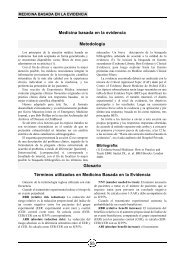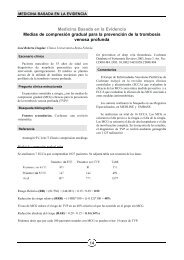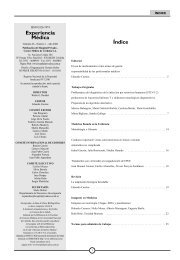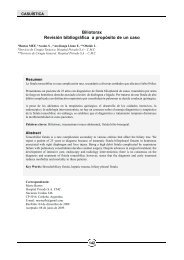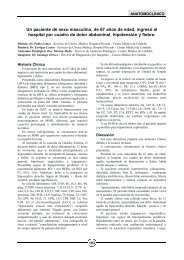HTLV-1/2 - Revista EXPERIENCIA MÉDICA
HTLV-1/2 - Revista EXPERIENCIA MÉDICA
HTLV-1/2 - Revista EXPERIENCIA MÉDICA
You also want an ePaper? Increase the reach of your titles
YUMPU automatically turns print PDFs into web optimized ePapers that Google loves.
ر°Ð®·ªïóîððèò¯¨¼ ðîñðéñîððè ïîæëç ÐZ¹·²¿ ïð<br />
Experiencia Médica - Vol. 26 - Nº 1 - 2008<br />
<strong>HTLV</strong>-1 y 5 <strong>HTLV</strong>-2) y las 63 muestras negativas.<br />
Además, la IFI mostró más sensibilidad que el Wb debido<br />
a que detectó 6 muestras positivas entre las 47 muestras<br />
indeterminadas por Wb. Estas 6 muestras positivas por IFI<br />
fueron concordantemente positivas por PCR (Tabla I).<br />
Las principales conclusiones se basan en los<br />
siguientes resultados: 12,8 % de las muestras<br />
indeterminadas por Wb fueron confirmadas positivas por IFI<br />
y PCR y el 70 % de las muestras fueron concordantemente<br />
negativas por IFI y PCR. Además, se encontraron resultados<br />
discordantes en el 17 % de las muestras, resultando estas<br />
positivas por IFI pero negativas por PCR.<br />
Basados en nuestros resultados proponemos que<br />
sean utilizados una combinación de ensayos serológicos<br />
para la confirmación de la presencia de anticuerpos contra<br />
<strong>HTLV</strong>-1/2. Básicamente proponemos que todas las<br />
muestras indeterminadas por Wb sean probadas por IFI.<br />
Todas las muestras que resulten negativas por IFI<br />
demostrarían ausencia de anticuerpos contra <strong>HTLV</strong>-1/2 y<br />
todas las muestras que resulten positivas por IFI deberán<br />
ser estudiadas por PCR.<br />
Así, las muestras concordantemente positivas por<br />
IFI y PCR confirman una infección por <strong>HTLV</strong>-1/2,<br />
mientras que el porcentaje muy bajo de los individuos con<br />
resultados discordantes (positivos por IFI y negativos por<br />
PCR) deberían ser estudiados en un seguimiento<br />
serológico.<br />
Este esquema propuesto permitiría realizar un<br />
diagnóstico confirmatorio rápido de la infección por<br />
<strong>HTLV</strong>-1/2, descartando rápidamente el alto porcentaje<br />
(70%) de los resultados indeterminados por Wb que<br />
corresponden a los casos en los que no existe infección y<br />
evitando, de este modo, la necesidad de recurrir a técnicas<br />
moleculares para la definición del diagnóstico y la<br />
ansiedad que genera en el paciente la opción de un<br />
seguimiento serológico.<br />
Agradecimientos<br />
Las autores agradecen a las Dras. Lisa Sen y<br />
Andrea Mangano del laboratorio de Biología Celular y<br />
Retrovirus, Hospital Nacional de Pediatría "J. P.<br />
Garrahan", Buenos Aires, Argentina por haber cedido<br />
amablemente muestras con patrones indeterminados por<br />
Wb para la infección con <strong>HTLV</strong>-1/2, las cuales fueron<br />
utilizadas en este estudio.<br />
Bibliografía<br />
1.Yoshida M, Miyoshi I, Hinuma Y. Isolation and characterization of retrovirus from<br />
cell lines of human adult T-cell leukemia and its implication in the disease. Proc Natl<br />
Acad Sci USA.; 79:2031-2035, 1982.<br />
2. Gessain A, Gout O. Chronic myelopathy associated with human T-lymphotropic<br />
virus type I (<strong>HTLV</strong>-I). Ann Intern Med.; 117:933-946, 1992.<br />
3. Jacobson S. Cellular immune responses to <strong>HTLV</strong>-I: Immunopathogenic role in<br />
<strong>HTLV</strong>-I associated neurologic disease. J Acq Immune Defic Synd and Hum<br />
Retrov.;13:S100-S106, 1996.<br />
4. Murphy E. The clinical epidemiology of Human T-lymphotropic virus type II<br />
(<strong>HTLV</strong>-II). J Acq Immune Defic Synd and Hum Retrov.;13:S215-S219, 1996.<br />
5. Igakura T, Stinchcombe JC, Goon PK, et al. Spread of <strong>HTLV</strong>-I Lymphocytes by<br />
Virus-Induced Polarization of the Cytoskeleton. Science 299:1713-1716, 2003.<br />
6. Plancoulaine S, Buigues RP, Murphy EL, et al. Demographic and familial<br />
characterization of <strong>HTLV</strong>-1 infection among an isolated, highly endemic population<br />
of African origin in French Guiana. Int J Cancer 76:331-336, 1998.<br />
7. Wiktor SZ, Pate EJ, Rosenberg PS, Mother-to-child transmission of human T-cell<br />
lymphotropic virus type I associated with prolonged breast-feeding. J Human Virol<br />
1:37-44, 1997.<br />
8. Gotuzzo E.<strong>HTLV</strong>-I: a new problem for Latin America? ASM News 67:144-146, 2001.<br />
9. Mahe A, Meertens L, Ly F, Human T-cell leukemia/lymphoma virus type 1-<br />
associated infective dermatitis in Africa: a report of five cases from Senegal. Br J<br />
Dermatol 150:958-965, 2004.<br />
10. Hjelle B. Human T-cell leukemia/lymphoma viruses: life cycle, pathogenicity,<br />
epidemiology and diagnosis. Arch Pathol Lab Med; 151:440-450, 1991.<br />
11. Kazura JW, Saxinger WC, Wenger J, et al. Epidemiology of human Tcell<br />
leukemia virus type I infection in East Sefck province, Papua New Guinea. J Inf Dis;<br />
155:1100-1107, 1987.<br />
12. Yanagihara R, Ajdukiewicz AB, Ganuto RM, et al. Human T-lymphotropic virus<br />
type I infection in the Salomon Islands. Ann J Trop Med Hyg; 44:122-130, 1991.<br />
13. Tajima K, Hinuma Y. Epidemiology of <strong>HTLV</strong>-I/II in Japan and the world. Gann<br />
Monograph on Cancer Research.; 39:129-149, 1992.<br />
12



